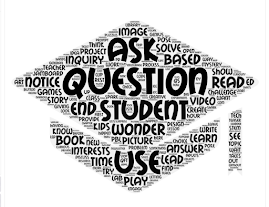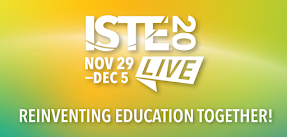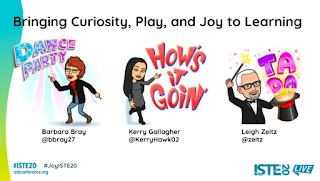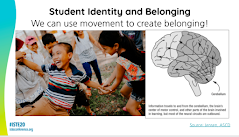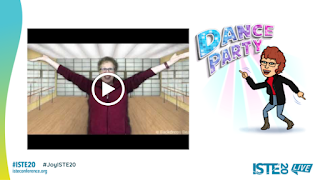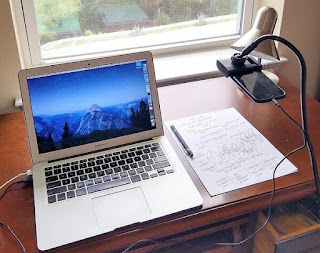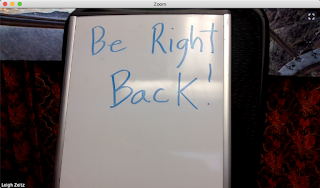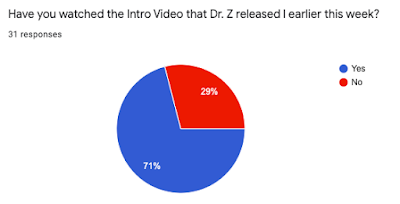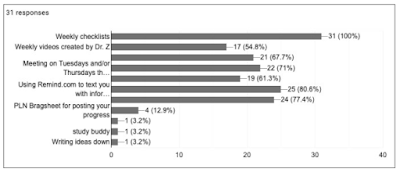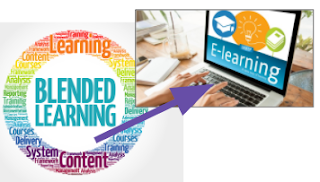As you read in my last posting, I am spending this week online enjoying the ISTE20 LIVE virtual conference. Yesterday, Barbara Bray and Kerry Gallagher and I presented our Experiencing Curiosity, Play, and Joy in Learning session. It was a BLAST but more importantly, our attendee educators shared a plethora of ideas for igniting curiosity in their students.
After introducing our discussion about Curiosity, I decided to ask our virtual room full of educators to share what they did to spark their students' curiosity.
Provoke Curiosity
Since we were online, I couldn't ask 330 individuals to raise their hands and tell us their strategies, so we used the Chat Room to get their input. The problem with using chat rooms for people to enter multiple sentence answers is that not everyone can type quickly. Some people can enter their complete answer while others are rushed.
We asked them to enter their ideas in chat but NOT click the SEND button. I gave them 90 seconds to enter their ideas and then, as a group, we ALL clicked the SEND button at the same time. *As you might guess, we were flooded with chat ideas. It was amazing. These were important so I gave them another 60 seconds to review them.
As you might guess, they didn't get a chance to review all of them so I have posted their ideas below.
How Do You Spark Curiosity In Your Students?
- QFT- Question Formulation Technique to get kids (and adults) to generate questions and narrow focus for inquiry
- Book talks
- 101qs.com, Problem-Based Learning, driving questions, asking questions when asked questions, putting a picture on a screen and having student create the question
- Using an interesting picture as a writing prompt
- Asking questions, providing labs/experiments/situations for students to observe and be curious about, using inquiry based learning, encourage students to play!
- Why questions ... mysteries to solve
- Flipping lessons- letting the students lead the way!
- Asking questions. Thought puzzles. Brain-teasers. Wait time!
- Design Thinking projects & using hidden pictures based on answers with conditional formatting in Sheets.
- Reading. Listening to podcasts. creative arts processing
- Maker Lab; Jamboard; asking students to notice; encouraging reading;
- Notice and wonder
- Providing puzzles, playing games, setting up a problem to solve, provide manipulatives, asking for multiple answers
- We celebrate "button poking" - that is, we cheer on students who try things without having any idea what might happen just because (poke buttons to see what they do) or to solve a problem.
- Creating Project-based learning based on interests- student choice!!
- Pose an intriguing question
- By being here at the ISTE conference to learn new interesting skills
- Showing images from new topics for students to notice and wonder about. In virtual I use Jamboard for this. :-)
- Hidden surprise in every lesson - did you find it? Wait until the end of class to write it on your ticket!
- Weekly ed tech newsletter
- Process Art
- Field trip experiences!
- Show how a programmed robot works, and then allow the students to reconstruct the code without seeing how it was done.
- Makerspaces, choice centers, sketchbooks prompts- answering them and drawing them and writing them for the rest of the school
- Giving time for educators a chance to ask and answer their own questions thru inquiry
- Read an excerpt from a chapter book and stop at the cliffhanger to get kids to check the book out from the library.
- Ask the question beginning "what if...?"
- Project Lead The Way
- Questions, photos, partial storytelling... leaving the rest of the story.
- Use the Challenge-based learning model to spark creative learner-led solutions
- HyperDocs with reflection questions posed in "why"
- Newsletters highlighting teachers who are using those strategies that other teachers might want to try. I also just ask "what is your biggest issues right now?" and work together to solve them
- When asked a question, say: "I don't know, how can we find out?"
- Disruptus
- Spark Curiosity by asking students --> What do you THINK you know? What do you WANT to know?
- Breakout boxes, mystery piles of books on the tables in the library
- The electoral college, 2 party system,
- More student agency!
- STEM, PBL, Talking circles, Genius Hours, Coding
- Research, Open ending questions,
- Using images and video clips to get students into inquiry mode before introducing a big topic.
- Look for discrepant event to engage surprise
- Using different apps like quizziz
- Asking questions, showing an image or video snippet, genius hour, giving 'playground time' when first trying a new tech tool
- Genius Hour
- Using mentor texts that get kids' attention.
- Share a story with a cliffhanger ending.
- Giving a teaser for "freebies" or templates at the end of teacher PD, but not saying what they are or what they look like.
- Have the kids ask a question about their community - what is something relevant to them? Then work collaboratively to create a solution.
- What do you notice, what do you wonder?
- Visible thinking routine, morning centres,
- Check-in questions
- Use the "What's happening in this Picture?" to generate questions....and then discuss all the questions....and then reveal the answer (got the idea from NY Times)
- The wall of why- lists of wonderings to tackle during why-finding Fridays
- Open-ended questioning with adults
- Question of the week on Flipgrid. I used to do 20 Time!
- I love to spark creativity with music and humor
- Deep questioning, hands-on displays, posters with interesting graphics, demonstrations
- Using Images and Objects. Students are required to pose questions about a visual presented, and their wonderings can often lead the conversation in variety of directions.
- I use visuals that make my students wonder about the upcoming unit.
- #AdobeCreativeEducator
- Starting with something engaging (a video clip, mystery science, trick, challenge, etc)
- Instead of asking pre-determined discussion questions, after reading a piece, I ask, "What's discussion-worthy here?" They always notice everything I wanted them to, plus more :)
- Ask questions about crazy animals facts, such as "Do cockatoos play catch?" Let them predict their answer, and then share a video.
- I do games to let them know what the class is going to be about, I play hangman or memory
- Hands-on projects and games
- Jamboard and Menti
- I'm inviting my students to design their own questions before starting their research
- I show the students that I'm the learner.
- Asking engaging questions, ice breakers, games, movement, STEM, student choice
- Personal connections and interests - Open exploration of online resources
- Pictures, videos,
- Inquiry, letting students take the lead, problem-based learning, multimedia, student creation
- Experimentation.
- Flipgrid
- Tying content to interests or something that matters to the individual
- Design challenges for teachers
- 3 Reads, Notice and wonder, stem activities, phenomena based instruction
- Stories: Tell a story through puppets, but leave the end for them to discover it in the reading.
- Ouch.... Curiosity in the classroom..... I worry that I am not curious enough this year!
- #BreakISTEchat
- I bring in random objects or images and teach students to ask questions. Tinker!!!
- Jamboard
- Makerspace challenges
- Inquiry process and questioning
- Read the first 2 chapters only of a book then place in our class library for children to finish
- I teach higher ed ELL where wonder and curiosity are often ignored/forgotten.
* This is a strategy that I learned from Dr. Doug Shaw. He calls it "Enter Key is Lava" because it is untouchable.
Word Cloud Image: Dr. Gordon Dahlby

